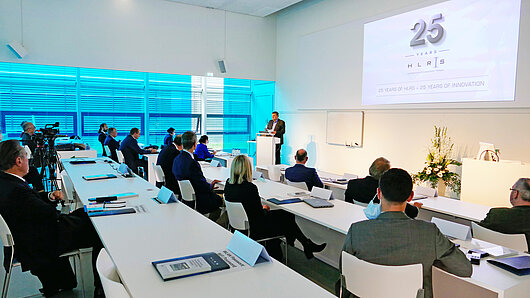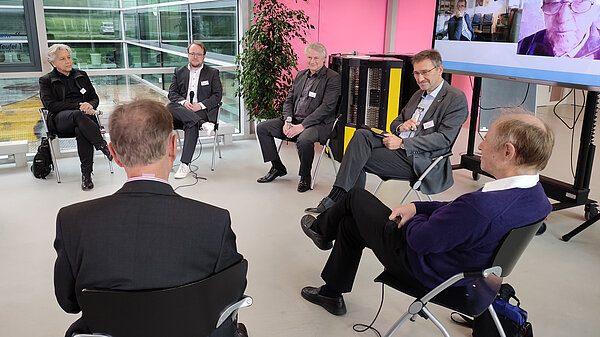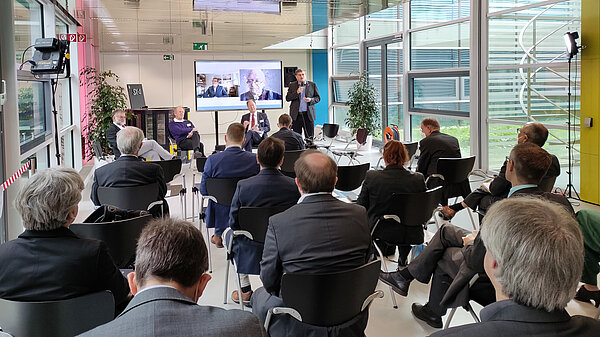High-Performance Computing Center Stuttgart

Prof. Wolfram Ressel, Rector of the University of Stuttgart, congratulated HLRS on its anniversary, remarking, "The high-performance computing center is a prominent example of the University of Stuttgart's excellent research infrastructure. For more than a quarter century Stuttgart's supercomputing has stood at the pinnacle of scientific and technological progress and is synonymous with visionary research and education, as well as for technology transfer in support of prosperity in industry and society. On the occasion of its anniversary celebration I congratulate all of the researchers who on a daily basis contribute to these exciting efforts for their internationally recognized achievements."

German Federal Minister of Education and Research Anja Karliczek also extended her congratulations on the anniversary: "High-performance computing is an important cornerstone for building technological sovereignty in Germany and Europe. By making reliable investments in the research and development of digital technologies we are ensuring our competitiveness. HLRS has been engaged at the intersection of science and industry for more than 25 years, and again and again its supercomputers have enabled ground-breaking achievements, for example in the simulation of more energy efficient airfoils. The high level of commitment of the staff at HLRS is crucial to this great success: thanks to them, algorithms and supercomputers are transformed into excellent research and innovation."
"The High-Performance Computing Center at the University of Stuttgart is among the largest and most important facilities for supercomputing worldwide," said Baden-Württemberg Minister of Science Theresia Bauer. "The past 25 years at HLRS have been a remarkable success story and its international visibility is of upmost importance for the state as a center for research. In its role as a competence center, HLRS is active in almost all areas of research, from engineering to the digital humanities, and makes essential contributions to key political fields such as the transition underway in the energy sector and the development of more environmentally sustainable mobility solutions."
The anniversary celebration brought together close partners from across the HLRS community to consider the center's accomplishments and contributions to science and industrial R&D. In the first half of the day, four panel discussions considered key aspects of HLRS's history and activities. HLRS Director Prof. Michael Resch, together with several of HLRS's "founding fathers" reflected on factors that led to the center's establishment, as well as how its technical infrastructure and expertise have grown in relevance for an expanding range of applications. SICOS BW Managing Director Dr. Andreas Wierse led a conversation focusing on how supercomputing supports industry and how models for technology transfer developed at HLRS promote competitiveness both for individual companies and for Europe as a whole. In a session moderated by HLRS Steering Committee Chair Prof. Wolfgang Nagel, long-time scientific users of HLRS's systems explained why HPC is essential for their work, what opportunities increased computing power could offer, and future challenges resulting from the need to manage and analyze increasingly massive data sets. Finally, HLRS Department of Philosophy Chair Prof. Andreas Kaminski spoke with former HLRS staff members, who reflected on their experience of completing PhD's at the center and their career development since then.

A more formal anniversary ceremony took place in the late afternoon. Guests of honor (either present or delivering greetings online) included University of Stuttgart Rector Prof. Wolfram Ressel, Federal Minister of Education and Research Anja Karliczek, and Baden-Württemberg Ministry of Science, Research, and Art Ministerial Director Dr. Hans Reiter. Representatives of the European Union, including Gustav Kalbe from the European Commission Directorate-General for Communications Networks, Content, and Technology (CNECT), and EuroHPC Joint Undertaking Managing Director Anders Dam Jensen recognized HLRS's contributions to supercomputing at the European level. The ceremony was capped by short lectures by senior representatives of several of HLRS's international partners, focusing on questions that the HPC community will address in the coming years. These included Prof. Dr. Jesus Labarta (Barcelona Supercomputing Center, Spain), Prof. Horst Simon (Lawrence Berkeley National Laboratory, USA), and Prof. Dr. Hiroaki Kobayashi (Tohoku University, Japan).
Looking toward HLRS's future, Michael Resch suggested that the demand for larger supercomputers, the emergence of new technologies like artificial intelligence and quantum computing, and the urgent need to make HPC more environmentally sustainable are three key factors that will drive HLRS's continuing evolution over the coming decade.
"As HLRS plans for its next-generation supercomputer, which we hope to inaugurate in 2026, we will face the twin challenges of constructing a new building and developing a new energy infrastructure that will meet the new supercomputer's significantly larger power requirements," Resch said in the pre-event press release. "A focus on maximizing efficiency will be particularly important as HLRS builds on its recent EMAS and Blue Angel certifications for environmental and energy management, and works toward the goal of becoming carbon neutral by 2032." Considering the role that simulation and data analysis have played in the global response to the ongoing Covid-19 pandemic, HLRS is also focused on addressing a growing need for urgent supercomputing resources that can be deployed quickly in crisis situations.
"Today is a day to look back with pride at what HLRS and its many partners have accomplished over the last 25 years," Resch said. "At the same time we look forward to continuing to provide new kinds of resources and solutions that will help scientists, technology creators, public administrators, and others across our society to address the many challenges that we face."
—Christopher Williams